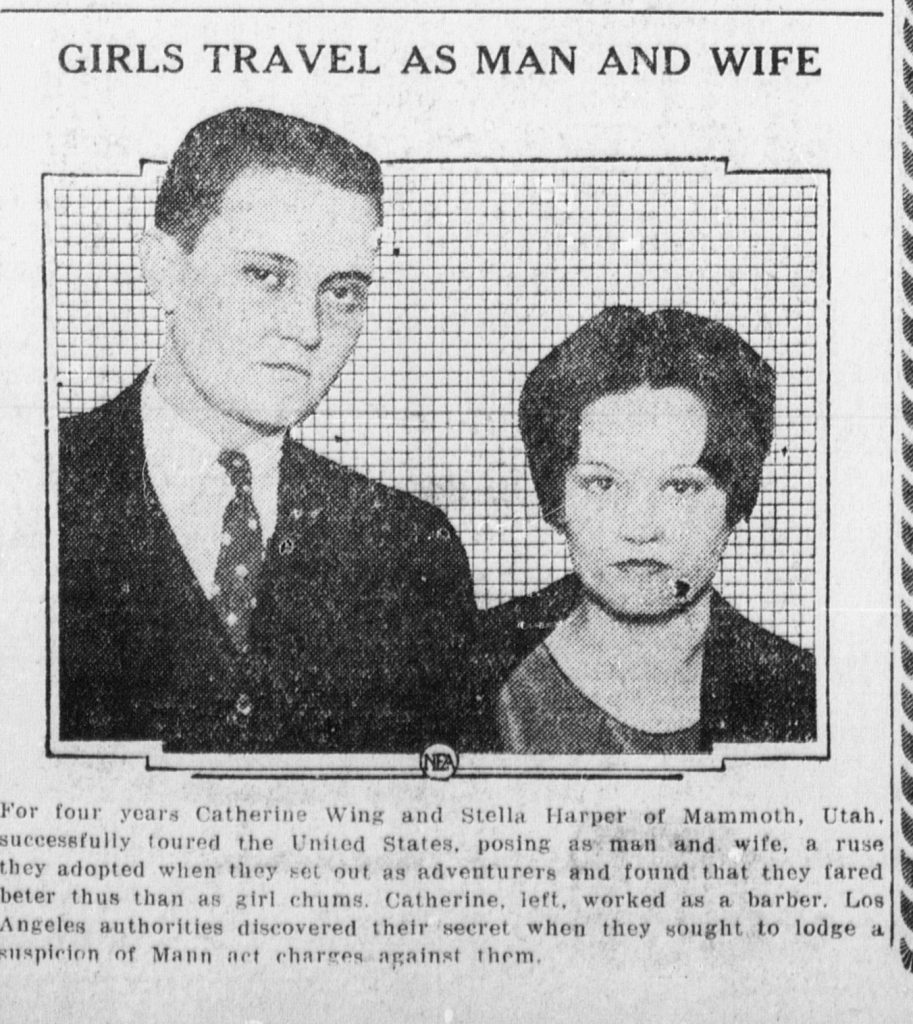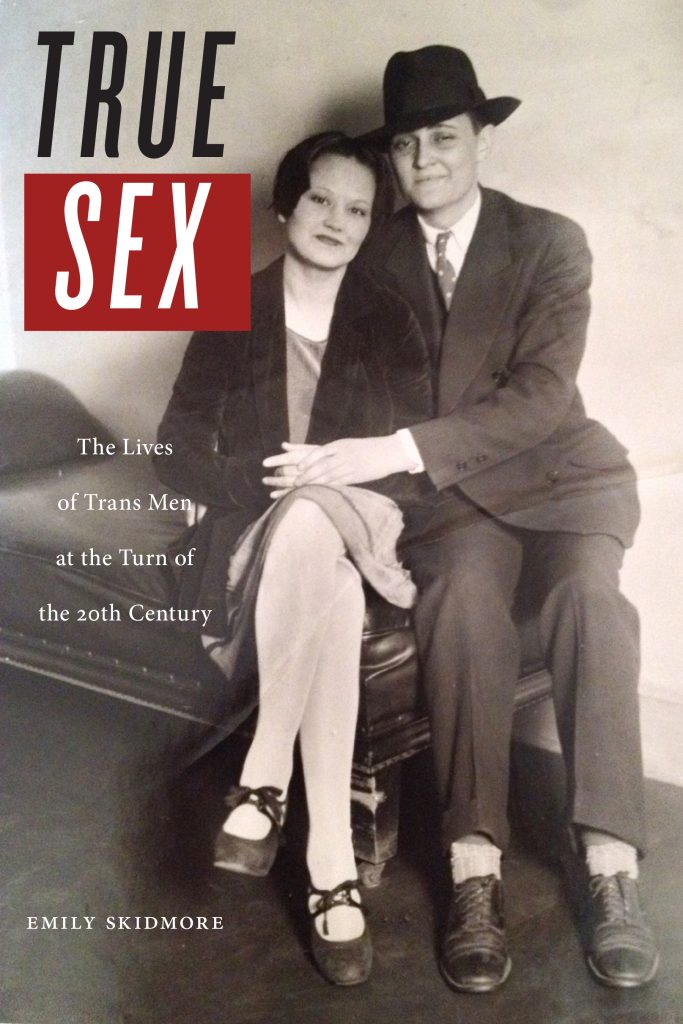I recently wrote a book about gender transgressions in the past (True Sex: The Lives of Trans Men at the Turn of the Twentieth Century). In that book, I discuss the stories of 18 individuals who were assigned female at birth but who lived as men in the United States between 1876 and 1936. This project took almost ten years to complete, and during that decade, the field of transgender history has exploded with new work and new lines of inquiry. And yet, there remains great debate over terminology, rightfully so, as language has tremendous power to make visible, to define, and to disrupt. There is also a violence inherent in language, as historians place labels on individuals who cannot speak for themselves, and who in some cases lived before modern identity categories like “transgender” existed. The debates over terminology are productive and help push the field forward, so I don’t dare hope this blog post will settle anything. Rather, I wish to explain my own choices and argue why I think it’s useful to use the term “trans men” to describe historical figures assigned female at birth who lived as men, even while acknowledging that no modern term can completely describe the lived reality of people in the past.
Some may raise an eyebrow at my use of the term “trans men” to describe individuals who lived several decades before the coining of the term transgender, as much ink has been spilled in debate over the soundness of this term when used to describe historical actors. For example, Scott Larson has recently argued,
transgender…remains a modern category that cannot simply be retroactively applied to a figure in the late eighteenth century. Moreover, gender is produced and challenged differently in different times and places. That is, the way in which gender was unmade and remade in early America was different from the ways that various transgender individuals and groups have sought to challenge gender categories in the twentieth and twenty-first centuries.
Similarly, Genny Beemyn has argued that
the best that we as historians can do is acknowledge individuals whose actions would seem to indicate that they might be what we would call ‘transgender’ or ‘transsexual’ today without necessarily referring to them as such and to distinguish them from individuals who might have presented as a gender different from the one assigned to them at birth for reasons other than a sense of gender difference.
Both Larson and Beemyn usefully highlight the significance of historical context, and warn us against uncritically deploying modern terms to describe the past, reminding us that identifications are historically contingent.
Given this, how should historians refer to their gender transgressive people? Settling on terminology was one of the most challenging aspects of completing my book, particularly because as a gender-conforming (cisgender) person, I am hyper-aware that the stakes of my words are different for me than they are for trans or gender non-conforming readers. Thus, a guiding principle of my work has always been to try to honor the gender identification of my historical subjects. Of course, determining gender identification can be challenging, as most gender transgressive figures speak to historians only through sources that are mediated. For example, when a trans man’s voice is present in a newspaper article, it is mediated through the questions posed by the journalist, as well as the choices of the editor of which answers to include, or how to edit those responses. And of course, the trans man’s responses may have been carefully curated in order to appeal to the expected audiences, and therefore may or may not be fully accurate. This adds to the complexity of assigning labels.

The people I chose to write about—the subjects I refer to as “trans men”—are individuals for whom I could find a consistent record of male presentation, even after many of them were arrested, detained by immigration officials, or otherwise threatened by authorities because of their gender transgressions. My choice to use “trans” instead of “transgender” was in hopes of signaling some tentativeness. As I wrote in the book’s introduction,
trans here suggests the ways in which the subjects of this book transitioned from the gender assigned to them at birth to the one with which they identified…. I have chosen to use it instead of “transgender” in hopes of conveying the open-ended nature of gender being made and remade.
Additionally, in order to again signal the tentativeness with which I believe we should approach all terminology, I use a second term in my book: “queer embodiment.” I use this term to refer to nonnormative forms of gender embodiment. To me, this term signals the dissonance between the sex assigned to individuals at birth and their gender presentation (i.e. the gender their community took for granted). As I wrote in the book,
I find the term queer embodiment particularly useful because it helps to register the nonnormative quality of certain bodies and yet refuses to fix them in the strict identity categories. The term, therefore, exists in productive tension with “trans men,” and it suggests the impossibility of any modern term conveying the historical reality of the subjects of this book.
This last line, to me, is the central point. We cannot know with any certainty the gender identification of historical cross-dressers, gender transgressors, or other trans figures, but we can do our best to approach their stories transparently to convey them with respect and dignity.
One of the things I have struggled to grapple with as a historian is that so much of the interior lives of our subjects will always be invisible to us. For example, it is possible that some individuals who sought to pass as male in public led private lives or intimate relationships wherein they identified as women. Because of this, in my own work, I choose to focus largely on representations: how were the lives of individuals who transgressed gender boundaries narrated in the press? How can we use newspaper stories—particularly those produced in the aftermath of the revelation of one’s “true sex”—as a window onto how communities defined norms around gender and sexuality? What meanings did the press ascribe to cross-dressing figures, and what does this reveal about popular understandings of the connection between gender, sexuality, race, and belonging? These are the questions that guide much of my work. To those ends, I deploy the term “true sex” to refer to one’s anatomy. Much of the drama of my book takes place after a community discovered the “true sex” of an individual who had lived—sometimes for decades—as a man. In my book, I always place the term “true sex” in quotes (much to the consternation of my copy editor!) because I sought to trouble the assumed connection between the sex assigned at birth and gender identity, and to challenge the idea that one’s anatomy is the source of “truth” about one’s identity.
At the end of the day, I think scholars working and writing in transgender history should not shy away from the difficult conversations we must have about terminology and pronouns, especially those of us (like me) who are cisgender. In fact, I think that cisgender scholars should bear a particular burden to think deeply about these issues given that our words describe experiences that we do not share personally, and therefore we should not be defensive when presented with alternative perspectives. I think we should do whatever we can to be respectful of the lives we represent in our scholarship and be willing to admit that we cannot know for certain how our historical subjects understood their gender. This is not a failure on the part of researchers in queer history; it is an honest assessment of the predicament that all historians face.
Even if we stumble, uncovering the history of trans expression in the past is tremendously important, particularly in the current political context of America. For example, just this summer, President Trump tweeted his decision that transgender individuals should no longer be allowed to serve in the military, despite the fact that trans people have fought and served in the U.S. military since at least the Civil War. To that end, utilizing (however tentatively) terms like “trans men” can be a powerful political tool, as it points to the fact that trans issues are not new and that trans individuals have a legacy of contributing to our nation for decades, if not centuries. At a time when politicians seek to strip transgender individuals of employment protections or prevent them from using the bathroom, historians have great power to speak back; using terms like “trans men” can highlight the long and deep history of gender transgression in the United States.

Emily Skidmore is an Assistant Professor of History at Texas Tech University, where she teaches courses on the history of gender and sexuality in the United States. In addition to True Sex, she is the author of work that has appeared in GLQ and Feminist Studies. She tweets from @eeskidmore.
Editors’ Note: In this final instalment of NOTCHES’ four-part series on trans history, historian Emily Skidmore takes on the perennial subject of labels. Trans histories often begin with discussions about terminology, but in this series we’ve chosen to end with labels, with the hope of prompting a continuing discussion among you, the readers. Is there a right answer to the question of which terms to use when discussing trans history, or queer history more generally? Should we retire the discussion altogether, accept each other’s language choices, and move on to the evidence? Or does the question of language get to the heart of transgender history as a field?

NOTCHES: (re)marks on the history of sexuality is licensed under a Creative Commons Attribution-NonCommercial-NoDerivatives 4.0 International License.
Based on a work at www.notchesblog.com.
For permission to publish any NOTCHES post in whole or in part please contact the editors at NotchesBlog@gmail.com





